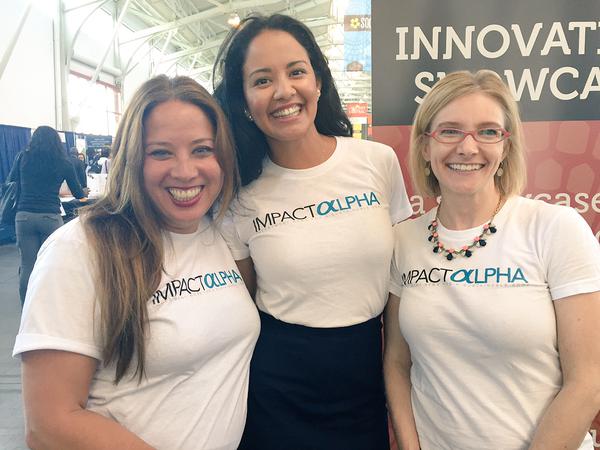ImpactAlpha reporters are fanning out across SOCAP, the Social Capital Markets conference, to catch conversations on sustainability in the supply chain for apparel, healthy food financing, fintech, conservation finance, and yes, the state of impact investing. Here’s some of what they have picked up:
- Mainstream investors are beginning to see impact investing as a diversification strategy. “We’re starting to have impact-agnostic investors invest because of the lack of correlation to the broader market,” said Gil Crawford, CEO of Microvest, an asset management firm with $380 million in assets that provides capital to microfinance institutions in the developing world.
- “Social risk” is emerging as a concern for impact investors. “What if we had social-risk adjusted [investment] vehicles, rather than financial risk-adjusted?” asked Clara Miller, president of the F.B. Heron Foundation, which is committed to investing 100 percent of assets in impact.
- Can we create markets for impact by paying for social outcomes? Ann Mei Chang, executive director of USAID’s Global Development Lab said that today’s social impact bonds (SIBs) and development impact bonds (DIBs) are only the beginning. “We need to accelerate our progress by effectively measuring our social progress and standardizing blended investments,” she said.
- “We can’t grant finance our way to sustainable and scalable solutions,” said Ross Massood from the UK’s Department of International Development. Massood is concerned about the investment readiness of the social enterprise sector and the enormous disparity between the trillions of dollars needed to move the needle on the new UN Sustainable Development Goals (SDGs) and the scale of investment opportunity in businesses focused on addressing these issues. “For ventures to go from grant capital to ‘capital plus’ is often a chaotic transition.”
- Added Cathy Clark: “The grant to investment handoff is broken.” Clark is the director of CASE i3 Initiative on Impact Investing at Duke University, which is testing Smart Impact Capital, a series of new online modules to help impact entrepreneurs raise capital in a fragmented impact investing marketplace.
- Generations of people will be growing up in refugee camps. “We have to keep innovating,” said Jan Piercy from Enclude, who said she was unaware of investors who were focusing on social investment and enterprise building in displaced communities. One idea: engage diaspora communities to invest in social impact ventures in their home countries.
- Entrepreneurs demand “radical transparency” from investors. Min Pease, Echoing Green Director of Impact Investing says the firm attempts to be the voice of its entrepreneur fellows. Entrepreneurs, she says, are increasing asking investors, “What’s your impact thesis?”
- The systems we set up for the consumption economy generate climate change and poverty, and both put vulnerable populations at great, perpetual risk. “Everyday that humans live, we are making the planet more dead,” said Shashi Buluswar of the Institute for Globally Transformative Technologies. How technology can make a difference to poor people living with the affects of climate change?
- Protecting biodiversity these days means working with working land – farms, lumber forests, fisheries. “How might soil improvement & storm water mitigation be structured as sweat equity for farmers on leased land?” asks Susan Phinney Silver of the Packard Foundation. Many farmers farm leased land: How do we engage people who don’t have a financial stake in conservation?
- SOCAP is always accompanied by the release of a slew of new reports. Among this year’s crop:
- “The State of the Field for Gender Lens Investing,” from Criterion Institute;
- “Frontier Capital: Early Stage Investing for Financial Returns and Social Impact in Emerging Markets,” from Omidyar Network;
- “Great Expectations: Mission Preservation and Financial Performance in Impact Investing,” from Wharton Social Impact;
- “Catalyzing Capital for Invention: Spotlight on India,” from the Lemelson Foundation.











